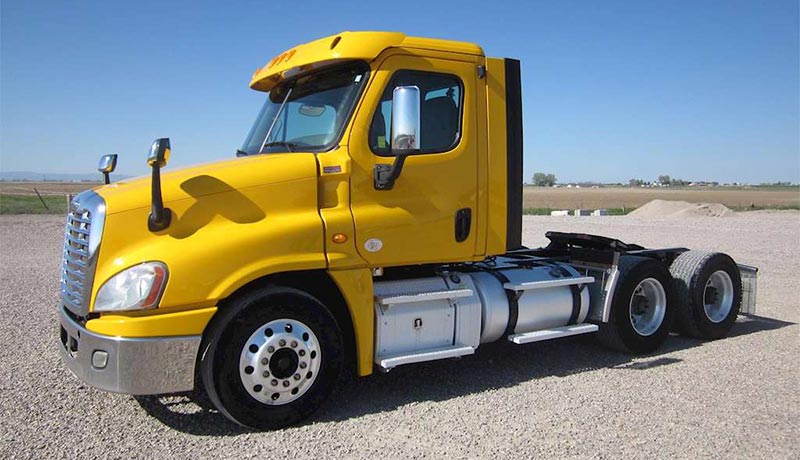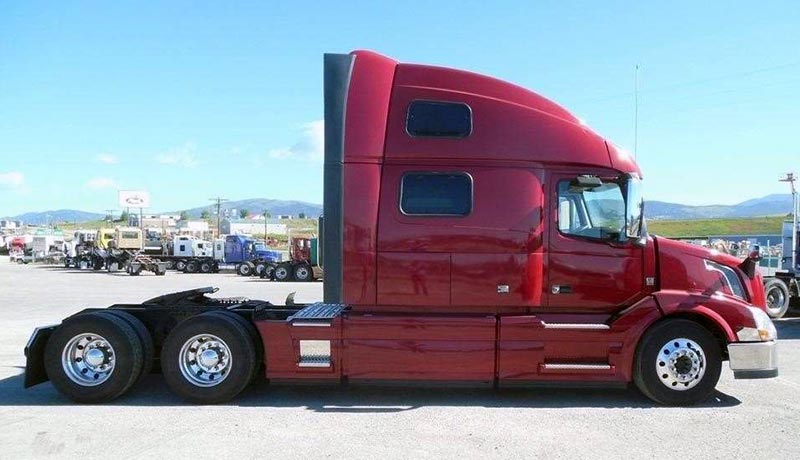Semi Trucks: The Ultimate Buying Guide
Shop 1000s of semis and know what to look for before making a purchase.
Semi trucks are heavy duty vehicles that are designed to safely and securely haul cargo on long routes that can take anywhere from hours to weeks to complete. From the different types of semi trucks available to semi truck weight limits to semi truck prices, this guide focuses on the most important aspects of modern day big rigs so that you can get straight to trucking.
Basic Terms to Know
There's some general confusion about the term "semi truck", where terms tend to get mixed up from region-to-region and state-to-state. Knowing these basic definitions will help you speak the right lingo:
- Semi Truck – This specifically refers to the truck cab (the part that holds the driver and the engine) and not the semi-truck and the semi-trailer together. Driving just the cab without a semi trailer attached is called "bobtailing".
- 18 Wheeler – Only use this term once the semi truck and semi trailer are linked together (forming 18 wheels). This is also called a tractor trailer.
- Semi Trailer – Unlike full trailers, a semi trailer has no front tires and can be detached. This makes transferring loads from truck to truck and storing loads at depots a whole lot easier.
Picking the Right Semi Truck for Sale
First, there are some basic considerations...
- Freight – The bigger the cargo, the bigger the semi truck needs to be.
- Terrain – The lay of the land matters. If you live in a flat area, for example, you probably won't need a semi with extra gears meant for braking while driving down mountainous inclines.
- Weather – Extreme climates will require extra adaptations such as weather stripping.
- Resale Value – Very few truckers will keep their vehicle until the end of its lifespan, so try make it as appealing as possible by keeping a traditional design that works for multiple industries.
- Route Length – Some semi trucks, like day cabs, are built for local deliveries (more on that in just a moment), while others are designed to go across the country and back.
- Fuel Efficiency – Larger semi trucks tend to have a lower mileage, but they can transport larger cargo – and more of it. Try to find a balance between storage capacity and good mileage at highway speeds. You want a semi truck that is large enough to reliably transport the cargo, yet small enough to get to its destination quickly.
...and then there are some advanced considerations:
- Horsepower – Anywhere from 400-600 horsepower is considered average for semis. Bigger engines generally last longer and don't have to work as hard as smaller engines. However, since they cost more to purchase and maintain, picking a larger engine than needed is usually not a cost-efficient trucking strategy.
- Transmission – A semi truck can have a drive-line combo transmission with anywhere from 10 to 18 gears. Having more gears to choose from helps drivers save fuel and have better handling.
- Radiators – Smaller radiators cost less, but they also lack the cooling power needed for big rigs with heavy loads.
- Tires – Different tires have different handling styles, durability ratings and mileages depending on the climate and terrain.
- Axles – The number of axles and their placements will determine the total amount of cargo that you can carry. The more axles, the more weight you can carry (but at the expense of higher price tags, maintenance repairs, and highway tolls). Similarly, axles that are spaced farther apart can carry heavier loads, but the semi-trailer will need to be shorter, which can sometimes decrease cargo space.
The Different Types of Semi Trucks

Day Cab Semi Trucks
Some truckers have shorter routes that can be done in a single day while other truckers have longer hauls that go through the night. Day cab trucks have a minimal design that is ideal for quick hauls. They are smaller, have less room for drivers in the cab and less axles in general, sacrificing basic amenities such as insulation and soundproof cabs in exchange for a considerably cheaper price tag.
Shop Day Cab Semi Trucks

Sleeper Semi Trucks
Sleeper semi trucks are designed for long hauls and are much more plush than day cabs in comparison, often sporting a kitchen area, bathroom, walking spaces and a nice bedroom to pull over and catch some rest in instead of searching for a motel. However, sleeper trucks cost more than day cabs and usually fit less cargo due to the additional rooms.
Shop Sleeper Semi Trucks
Semi trucks can be further divided into two sub-categories for the front...
- Slope-Nosed Trucks – A shorter, more rounded semi truck allows you to have a longer trailer (and therefore more cargo) while still falling within the federal highway length restrictions. This is also sometimes called a "flat-nosed" truck.
This design generally makes for a bumpier ride since the driver sits directly over the front wheels.
- Conventional Nose — "Classic" models have a traditional hood length, which makes it easier to access the engine, but is also rumored to have a worse fuel mileage than slope-nosed trucks.
...and two more special sub-categories for the roof:
- Mid-Roof – The roof has been lowered for a more aerodynamic design that saves on fuel.
- Raised Roof – The roof is about 12-18 inches higher for additional storage space and sometimes an extra sleeping bunk.
Big Rig Size Classes
Semis typically cover three different weight classes:
- Class 6: 19,501 to 26,000 pounds
- A single-axle semi truck
- A beverage truck
- Class 7: 26,000 to 33,000 pounds
- Class 8: Over 33,001 pounds
- Some tractor trailers (mostly sleeper cabs)
Semi Truck Weight Limits
Federal law does not allow semi trucks to weigh more than 80,000 pounds on U.S. highways. To be more specific:
- The semi-trailer can weigh no more than 34,000 pounds.
- The steers (front wheels) can take no more than 12,000 pounds.
- The drives can take no more than 34,000 pounds.
 Federal weight restrictions are designed to preserve the integrity of highway roads.
Federal weight restrictions are designed to preserve the integrity of highway roads.
Semi Truck Length and Width Limits
According to the Federal Highway Administration:
Semi trucks can be no longer than 102 inches wide, except in Hawaii (where the legal limit is 108 inches).
As for length...
- A semi truck with a single semi trailer must be at least 48-feet long.
- A semi truck with two semi trailers connected together (called a "B-Train" connection) must be at least 28 feet in length.
 "B-Train" semi trucks (above) can be as little as 28 feet.
"B-Train" semi trucks (above) can be as little as 28 feet.
How Much Does a Semi-Truck Cost?
A new semi truck can start as low as $80,000 (for a single-axle day cab) and run as high as $150,000 for a deluxe sleeper cab, though you can easily add an extra $50,000 if you want to splurge on the latest comfort and design features. Keep in mind that a new semi truck is generally built to last 1,000,000 miles before it needs any serious overhauls or rebuilds.
As for semi trucks for sale, a big rig that is "almost new" can be as high as $100,000; a 7-year-old semi truck with low mileage can be as little as $30,000; a high-mileage semi truck in poor condition can be as low as $10,000.
Features
Keep these optional features in mind depending on your trucking needs:
- Fairings – Either metal or plastic fixtures that reduce drag to increase efficiency.
- Side Skirts – These protective side coverings keep wind resistance under the trailer at a minimum, speeding up your ride.
- Wide Tires – Wider tires can improve road handling.
- Aluminum Wheels – Lightweight wheels takes some of the strain off of your axles, allowing you to transport heavier loads.
- Low Rolling Resistance – Tires with low-roll resistance require less energy to turn, reducing fuel consumption.
- Mud Flaps – High-tech mud flaps are actually designed to decrease wind resistance, increasing fuel efficiency in return.
- Computer-Controlled Transmissions – Newer big rigs use digital sensors to control the transmission for better mileage.
Semi Truck Financing and Leasing
Financing or leasing new and used semi trucks is a practical way to get the vehicle first and earn the money later. In general, payments for a $75,000 commercial semi truck will be about 5% lower than payments for a $15,000 commercial semi truck.
Don't forget to check out our commercial truck financing and leasing guides for more information.
How to Check a Used Semi Truck for Sale Before Buying
Before you buy any used semi trucks, check them for:
- Logs – Maintenance logs and the number of hours or miles logged will help give you a clear picture of how well this semi was maintained and how much longer it will last. Make sure the tires were all changed at the same time (so they all have the same mileage) – if the logs show a flat tire replaced here and there, then that's fine. A seller who is lacking logs shouldn't automatically be written off.
- Rust – Payloads are not safe inside of rusty semi trailers. Look at the semi truck during the daylight hours and look everywhere. Sometimes rust will appear as raised spots just under the surface that are hardly noticeable, so be thorough.
- Windows and Doors – Any loose seals can cause air resistance and slow you down on the road.
- Tires – Aside from checking the treads, you should also look for cracks and bent hubcaps as these could be signs of overloading the truck (shortening its lifespan and increasing wear-and-tear), underinflating the tires, or parking in wet areas (which is bad for the suspension). Make sure the tires are made from the same manufacturer. Aside from demonstrating that the owner cares, tires also have their own specifications and maintenance routines.
- Engine – No leaks, no smoke, no dirt, no rust, no bad cables and no strange noises.
- Oil – Most semis can hold over 15 gallons of oil, so make sure it's clean.
- Brakes – Must not have any corrosion.
- Lights – Make sure all of the lights work for maximum efficiency and also to avoid being fined for safety violations.
- Seat – A proper, comfortable seat will keep you well-rested and prevent fatigue.
- The Real Reason for Selling – Be assertive (but never rude) as you seek an honest answer from the seller. Pay attention to their body language and voice tone (and if they try to change the subject, take it as a major red flag).
Tractor Trailer Driver Occupational Statistics
In 2016, Texas employed 175,780 tractor trailer drivers, the most out of any state; the average hourly wage for that year in Texas was $20.59, and the annual wage was $42,830. California was the second biggest hirer with 130,640 drivers employed at $1.00 more an hour and about $2,000 more a year than in Texas. But if you want the absolute best wages, move to North Dakota: they only employed 12,210 drivers in 2016, but they earned $25.83 on average, and $53,720 a year.
Ready for a Big Rig?
As one of the largest heavy equipment sales platforms, My Little Salesman lists thousands of new and used day cabs for sale and semi trucks for sale with sleepers by owner-operators and dealers. Whether you need to go all the way across the country or stay within state lines, we have the right day cabs and sleeper trucks listed for you and your payload!